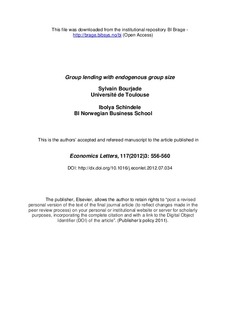| dc.contributor.author | Bourjade, Sylvain | |
| dc.contributor.author | Schindele, Ibolya | |
| dc.date.accessioned | 2013-02-20T11:46:23Z | |
| dc.date.available | 2013-02-20T11:46:23Z | |
| dc.date.issued | 2012 | |
| dc.identifier.issn | 1873-7374 | |
| dc.identifier.uri | http://hdl.handle.net/11250/93766 | |
| dc.description | This is the authors’ accepted and refereed manuscript to the article | no_NO |
| dc.description.abstract | This paper focuses on the size of the borrower group in group lending. We show that, when social ties in a community enhance borrowers incentives to exert e¤ort, a pro t-maximizing nancier chooses a group of limited size. Borrowers that would be fundable under moral hazard but have insu¢ cient social ties do not receive funding. The result arises because there is a trade-o¤ between raising pro ts through increased group size and providing incentives for borrowers with less social ties. The result may explain why many micro-lending institutions and rural credit cooperatives lend to groups of small size | no_NO |
| dc.language.iso | eng | no_NO |
| dc.publisher | Elsevier | no_NO |
| dc.subject | Group lending | no_NO |
| dc.subject | Moral Hazard | no_NO |
| dc.subject | Social capital | no_NO |
| dc.title | Group lending with endogenous group size | no_NO |
| dc.type | Journal article | no_NO |
| dc.type | Peer reviewed | no_NO |
| dc.source.pagenumber | 556-560 | no_NO |
| dc.source.volume | 117 | no_NO |
| dc.source.journal | Economics Letters | no_NO |
| dc.source.issue | 3 | no_NO |
| dc.identifier.doi | 10.1016/j.econlet.2012.07.034 | |
